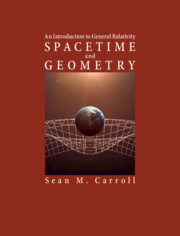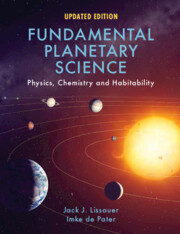Refine listing
Actions for selected content:
17001 results
5 - The Schwarzschild Solution
-
- Book:
- Spacetime and Geometry
- Published online:
- 31 July 2019
- Print publication:
- 08 August 2019, pp 193-237
-
- Chapter
- Export citation
1 - Special Relativity and Flat Spacetime
-
- Book:
- Spacetime and Geometry
- Published online:
- 31 July 2019
- Print publication:
- 08 August 2019, pp 1-47
-
- Chapter
- Export citation

An Introduction to Radio Astronomy
-
- Published online:
- 06 August 2019
- Print publication:
- 22 August 2019

Spacetime and Geometry
- An Introduction to General Relativity
-
- Published online:
- 31 July 2019
- Print publication:
- 08 August 2019
-
- Textbook
- Export citation

Fundamental Planetary Science
- Physics, Chemistry and Habitability
-
- Published online:
- 26 July 2019
- Print publication:
- 04 July 2019
-
- Textbook
- Export citation
7 - Unseen Planetary Interiors
-
- Book:
- Planetary Geoscience
- Published online:
- 25 June 2019
- Print publication:
- 11 July 2019, pp 114-127
-
- Chapter
- Export citation
1 - Exploring the Solar System
-
- Book:
- Planetary Geoscience
- Published online:
- 25 June 2019
- Print publication:
- 11 July 2019, pp 1-17
-
- Chapter
- Export citation
4. - Observing the Stars and Planets: Clockwork of the Universe
-
- Book:
- The Cosmos
- Published online:
- 08 January 2021
- Print publication:
- 11 July 2019, pp 74-105
-
- Chapter
- Export citation
15 - Physical and Chemical Changes:
-
- Book:
- Planetary Geoscience
- Published online:
- 25 June 2019
- Print publication:
- 11 July 2019, pp 258-275
-
- Chapter
- Export citation
4 - Solar System Raw Materials
-
- Book:
- Planetary Geoscience
- Published online:
- 25 June 2019
- Print publication:
- 11 July 2019, pp 66-79
-
- Chapter
- Export citation
17. - Quasars and Active Galaxies
-
- Book:
- The Cosmos
- Published online:
- 08 January 2021
- Print publication:
- 11 July 2019, pp 522-551
-
- Chapter
- Export citation
8. - Pluto, Comets, Asteroids, and Beyond
-
- Book:
- The Cosmos
- Published online:
- 08 January 2021
- Print publication:
- 11 July 2019, pp 224-261
-
- Chapter
- Export citation
13. - The Death of Stars: Recycling
-
- Book:
- The Cosmos
- Published online:
- 08 January 2021
- Print publication:
- 11 July 2019, pp 380-413
-
- Chapter
- Export citation
12 - Planetary Atmospheres, Oceans, and Ices
-
- Book:
- Planetary Geoscience
- Published online:
- 25 June 2019
- Print publication:
- 11 July 2019, pp 210-225
-
- Chapter
- Export citation
17 - Integrated Planetary Geoscience
-
- Book:
- Planetary Geoscience
- Published online:
- 25 June 2019
- Print publication:
- 11 July 2019, pp 294-315
-
- Chapter
- Export citation
10. - Our Star: The Sun
-
- Book:
- The Cosmos
- Published online:
- 08 January 2021
- Print publication:
- 11 July 2019, pp 288-315
-
- Chapter
- Export citation
Copyright page
-
- Book:
- Planetary Geoscience
- Published online:
- 25 June 2019
- Print publication:
- 11 July 2019, pp vi-vi
-
- Chapter
- Export citation
12. - How the Stars Shine: Cosmic Furnaces
-
- Book:
- The Cosmos
- Published online:
- 08 January 2021
- Print publication:
- 11 July 2019, pp 356-379
-
- Chapter
- Export citation
Brief Contents
-
- Book:
- The Cosmos
- Published online:
- 08 January 2021
- Print publication:
- 11 July 2019, pp vii-xvii
-
- Chapter
- Export citation
Epilogue
-
- Book:
- Planetary Geoscience
- Published online:
- 25 June 2019
- Print publication:
- 11 July 2019, pp 316-319
-
- Chapter
- Export citation
